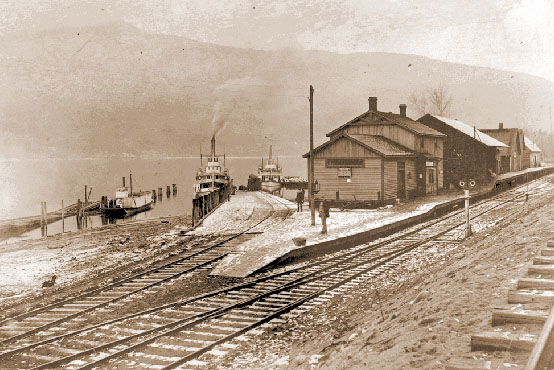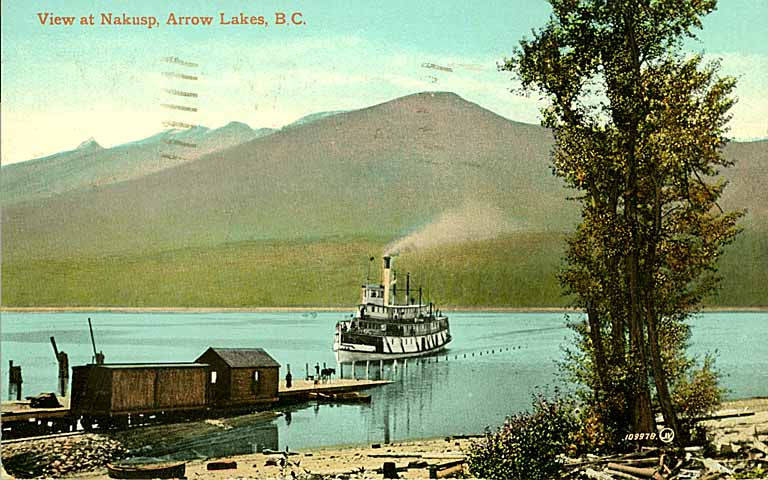Nakusp and Slocan Railway on:
[Wikipedia]
[Google]
[Amazon]
The Nakusp and Slocan Railway (N&S) is a historic Canadian railway that operated in the
 In July 1893, D. McGillivray, manager of the Inland Development & Construction Co., the principal contractor, commenced work. Progressing southeastward, the rail head from Nakusp reached Rosebery in August 1894 and Three Forks that October. The route attracted a $3,200 per mile grant. Whereas horse packtrains had carried ore from the surrounding mines to
In July 1893, D. McGillivray, manager of the Inland Development & Construction Co., the principal contractor, commenced work. Progressing southeastward, the rail head from Nakusp reached Rosebery in August 1894 and Three Forks that October. The route attracted a $3,200 per mile grant. Whereas horse packtrains had carried ore from the surrounding mines to
 A washout in June 1909, closed the Sandon extension until that October. Furthermore, the steep N&S grades, especially on this section, proved expensive to operate throughout the life of the line.
In 1913, the N&S completed rebuilding the abandoned K&S track, creating a Nakusp–Kaslo through service.
Passenger travel northeast of Rosebery ceased in 1933. Damage from the 1955 floods on Carpenter Creek ended all traffic east of Denver Canyon. Passenger service on the line and lake ferry finished in 1954. The final freight run on these sections was either December 1988 or March 1989. However, the latter service had reduced to twice weekly by the 1960s and once weekly by 1980.
A washout in June 1909, closed the Sandon extension until that October. Furthermore, the steep N&S grades, especially on this section, proved expensive to operate throughout the life of the line.
In 1913, the N&S completed rebuilding the abandoned K&S track, creating a Nakusp–Kaslo through service.
Passenger travel northeast of Rosebery ceased in 1933. Damage from the 1955 floods on Carpenter Creek ended all traffic east of Denver Canyon. Passenger service on the line and lake ferry finished in 1954. The final freight run on these sections was either December 1988 or March 1989. However, the latter service had reduced to twice weekly by the 1960s and once weekly by 1980.
West Kootenay
The Kootenays or Kootenay ( ) is a region of southeastern British Columbia. It takes its name from the Kootenay River, which in turn was named for the Kutenai First Nations people.
Boundaries
The Kootenays are more or less defined by the Kootenay ...
region of southeastern British Columbia
British Columbia (commonly abbreviated as BC) is the westernmost province of Canada, situated between the Pacific Ocean and the Rocky Mountains. It has a diverse geography, with rugged landscapes that include rocky coastlines, sandy beaches, ...
. The N&S initially connected Nakusp
The Village of Nakusp (Sinixt ''neqo'sp'') is beside the mouth of Kuskanax Creek, on the Upper Arrow Lake in the West Kootenay region of southeastern British Columbia. Lying between the Selkirk and Monashee ranges, the village is known for its ...
and Three Forks but soon extended to Sandon.
Proposal
The 1891 discovery of silver in the Slocan Range created a mining boom. A railway to transport ore was crucial for commercial mining. In 1892, the province issued the N&S charter, which theCanadian Pacific Railway
The Canadian Pacific Railway (french: Chemin de fer Canadien Pacifique) , also known simply as CPR or Canadian Pacific and formerly as CP Rail (1968–1996), is a Canadian Class I railway incorporated in 1881. The railway is owned by Canadi ...
(CP) leased the next year. Steamboat
A steamboat is a boat that is marine propulsion, propelled primarily by marine steam engine, steam power, typically driving propellers or Paddle steamer, paddlewheels. Steamboats sometimes use the ship prefix, prefix designation SS, S.S. or S/S ...
connections on Upper Arrow Lake
The Arrow Lakes in British Columbia, Canada, divided into Upper Arrow Lake and Lower Arrow Lake, are widenings of the Columbia River. The lakes are situated between the Selkirk Mountains to the east and the Monashee Mountains to the west. Beach ...
, were northward from Nakusp to a spur from the CP main line at Revelstoke. About this time, the Kaslo and Slocan Railway The Kaslo and Slocan Railway (K&S) is a historic railway that operated in the West Kootenay region of southeastern British Columbia. The K&S connected Kaslo and Sandon. Initially a narrow-gauge railway, the line was later rebuilt to standard gauge. ...
(K&S), a Great Northern Railway subsidiary, received a competing charter for a route westward from Kaslo
Kaslo is a village on the west shore of Kootenay Lake in the West Kootenay region of southeastern British Columbia. A member municipality of the Central Kootenay Regional District, the name derives from the adjacent Kaslo River. At 2016, the p ...
.
Construction
 In July 1893, D. McGillivray, manager of the Inland Development & Construction Co., the principal contractor, commenced work. Progressing southeastward, the rail head from Nakusp reached Rosebery in August 1894 and Three Forks that October. The route attracted a $3,200 per mile grant. Whereas horse packtrains had carried ore from the surrounding mines to
In July 1893, D. McGillivray, manager of the Inland Development & Construction Co., the principal contractor, commenced work. Progressing southeastward, the rail head from Nakusp reached Rosebery in August 1894 and Three Forks that October. The route attracted a $3,200 per mile grant. Whereas horse packtrains had carried ore from the surrounding mines to New Denver
New Denver is at the mouth of Carpenter Creek, on the east shore of Slocan Lake, in the West Kootenay region of southeastern British Columbia. The village is west of Kaslo on Highway 31A, and southeast of Nakusp and northeast of Slocan on ...
, Three Forks became the new aggregation point.
The advance of the K&S toward Sandon, the vicinity of the most important mines, prompted the N&S to also extend to that destination. Arriving in December 1895, regular service began. The festering CP and GN antagonism flared up between the N&S and K&S. That month, K&S crews set loose occupied N&S cars, demolished a bridge, track, a freight shed, and the station, and attacked repair crews. CP subsequently relocated the station and track from disputed land.
Operation
Initially offering lower rates than the N&S, the K&S carried over 80 per cent of Slocan ore, but the proximity of track to the mines determined the carrier in most instances. Agreeing to avoid rate wars, a tenuous truce existed. From 1897, the Rosebery–Slocan City
The Village of Slocan is in the West Kootenay region of southeastern British Columbia. The former steamboat landing and ferry terminal is at the mouth of Springer Creek, at the foot of Slocan Lake. The locality, on BC Highway 6 is about by roa ...
ferry southward across Slocan Lake linked to the CP Columbia and Kootenay Railway
The Columbia and Kootenay Railway (C&KR) was a historic railway operated by the Canadian Pacific Railway (CPR) in the West Kootenay region of British Columbia. This route, beside the unnavigable Kootenay River, linked Nelson, British Columbia, Nel ...
(C&K). Low water and ice on the narrows of the Arrow Lakes made the water route south to Robson (which connected to Nelson
Nelson may refer to:
Arts and entertainment
* ''Nelson'' (1918 film), a historical film directed by Maurice Elvey
* ''Nelson'' (1926 film), a historical film directed by Walter Summers
* ''Nelson'' (opera), an opera by Lennox Berkeley to a lib ...
and the Trail
A trail, also known as a path or track, is an unpaved lane or small road usually passing through a natural area. In the United Kingdom and the Republic of Ireland, a path or footpath is the preferred term for a pedestrian or hiking trail. Th ...
smelter) unreliable. The combined N&S, ferry, and C&K bypassed this problematic section. To avoid difficult grades on the main line, much eastbound freight was diverted to the route during the early 1900s. Trains were split in half to ascend the steep grade on the Nakusp–Rosebery portion. The route lost importance with the completion of the southern main line in 1915.
 A washout in June 1909, closed the Sandon extension until that October. Furthermore, the steep N&S grades, especially on this section, proved expensive to operate throughout the life of the line.
In 1913, the N&S completed rebuilding the abandoned K&S track, creating a Nakusp–Kaslo through service.
Passenger travel northeast of Rosebery ceased in 1933. Damage from the 1955 floods on Carpenter Creek ended all traffic east of Denver Canyon. Passenger service on the line and lake ferry finished in 1954. The final freight run on these sections was either December 1988 or March 1989. However, the latter service had reduced to twice weekly by the 1960s and once weekly by 1980.
A washout in June 1909, closed the Sandon extension until that October. Furthermore, the steep N&S grades, especially on this section, proved expensive to operate throughout the life of the line.
In 1913, the N&S completed rebuilding the abandoned K&S track, creating a Nakusp–Kaslo through service.
Passenger travel northeast of Rosebery ceased in 1933. Damage from the 1955 floods on Carpenter Creek ended all traffic east of Denver Canyon. Passenger service on the line and lake ferry finished in 1954. The final freight run on these sections was either December 1988 or March 1989. However, the latter service had reduced to twice weekly by the 1960s and once weekly by 1980.
Route
From Nakusp, the line climbed steeply to Summit Lake and descended to Hills on Slocan Lake, encompassing a 2.5 per cent grade. The railway bordered the lake's eastern shore via Rosebery. Bypassing New Denver, a 2.5 per cent climb followed Carpenter Creek terminating at Three Forks, situated over below Payne Bluff. The southeastward Three Forks to Sandon extension presented a 4.5 per cent grade.Rail trails
The Nakusp & Slocan Trail comprises Nakusp–Rosebery. North of Summit Lake is well maintained, but south is more rudimentary. The Rosebery to Three Forks Regional Trail (Galena Trail) covers the named section. A designated non-motorized greenway, the latter is well managed.Footnotes
References
* {{DEFAULTSORT:Nakusp Slocan Railway Defunct British Columbia railways Slocan Valley Canadian Pacific Railway subsidiaries